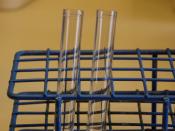INTRODUCTION
Enzymes are a protein serving as a catalyst, a chemical agent that changes the rate of the reaction without being consumed by the reaction. Enzymes are proteins made up of long chains of amino acids. These form complex shapes. The enzymes are individuals, like the different players on a ball team, they have different specific structures and jobs. As one ball player may be very tall and one short, the specific different shape of the active site on an enzyme is unique and prepares it to mix with a certain substrate. Without enzymes, the process of metabolism would be hopelessly slow. The reactant an enzyme acts on is referred to the enzyme's substrate. The enzyme will combine with or to its substrate. While the two are joined, the substrate is converted to its product by catalytic action of the enzyme. There is an active site of the enzyme molecule which is a restricted region that actually attaches to the substrate.
Usually the active site is formed by only a few of the enzyme's amino acids, the rest is just the framework that reinforces the active site. In an enzymatic reaction, the substrate enters the active site then is held in place by weak bonds. Now the enzyme does its work and first changes shape so it can hold onto the substrate. Next the substrate is changed to its product, the product is released and the enzymes active site is ready and waiting for another molecule of substrate.
Amylase is an enzyme in human saliva and in other organisms and its substrate is starch. When the active site of amylase binds with the starch, hydrolysis takes place. When the hydrolysis (the breaking of a chemical bond with the insertion of the ions of a water molecule) of starch is complete...


